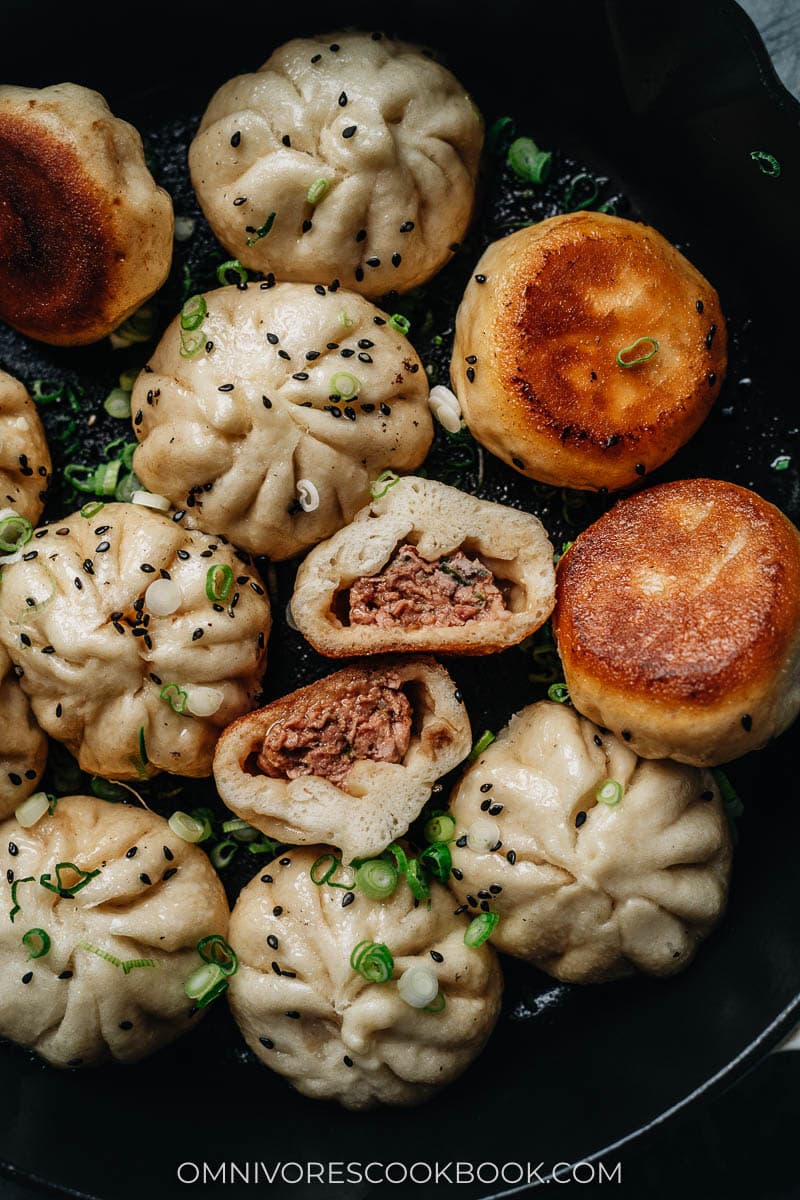
What is Sheng Jian Bao
Sheng Jian Bao (生煎包), or directly translated as raw fried buns, is one of the signature dishes from Shanghai. By “raw”, it means you pan fry the buns without steaming them first, in which process the dough will rise and the bottom crisp up at the same time. The pan-fried pork bun is different from the steamed stuffed buns (known as ‘baozi’), which is steamed only.
The filling is savory pork and green onion with a soupy texture. Imagine crispy potstickers, soup dumplings, and fluffy bread all combined together! One bite into it, and it awakens your taste buds with all the different textures and a rich umami.
Since the 1900s, the people of Shanghai have enjoyed this tasty bun for breakfast, and now you can enjoy it at any time you like in your own kitchen.
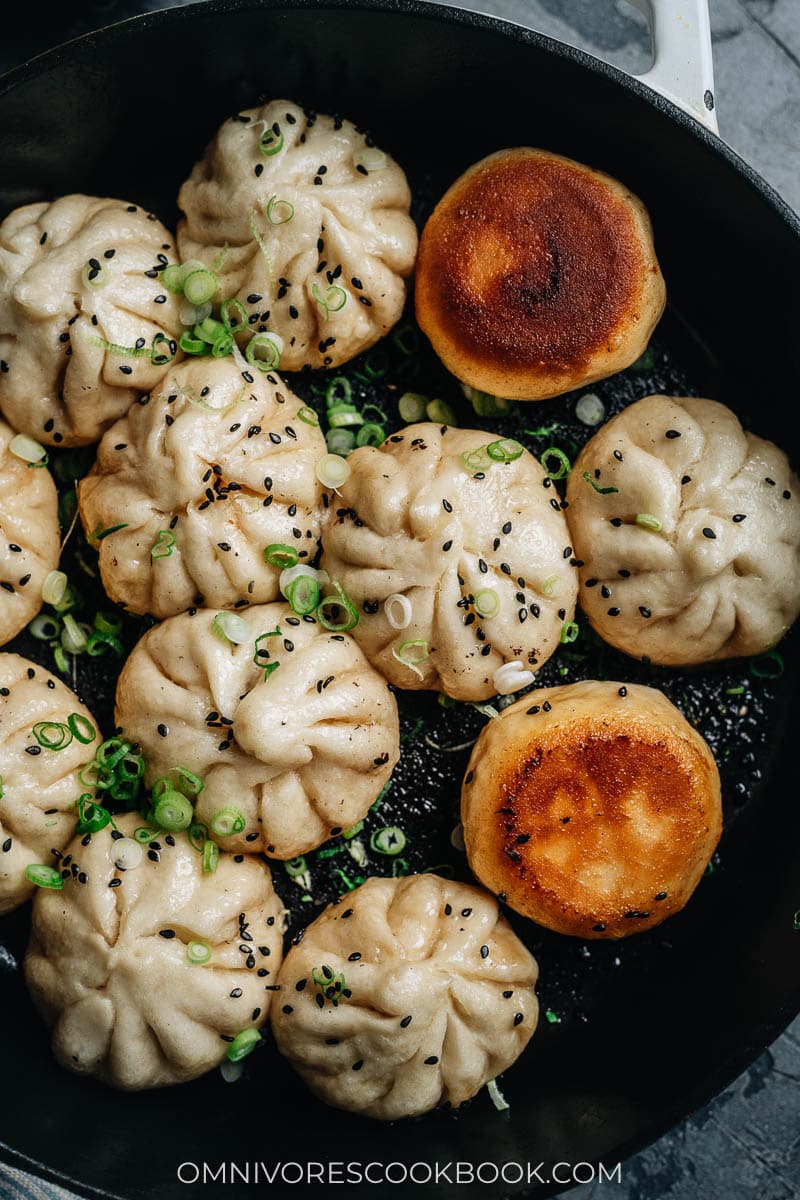
Why this recipe
No gelatin required yet very juicy
While many recipes for sheng jian bao use pork gelatin to create a soup-dumpling-like texture, it’s a time-consuming process. It requires pork skin or trotters, braised for many hours to get a rich soup, then chilled overnight.
Plus, the yeast buns tend to absorb the soup during and after cooking, so they don’t even come out soupy.
This version I have for you uses ginger-soaked water to increase the moisture in the filling so you get a juicy texture, yet it simplifies the cooking process. You can make it even juicier than that by using a fattier ground pork, like the type with 30% fat.
Once cooked, the Sheng Jian Bao will have a very juicy and almost soupy filling.
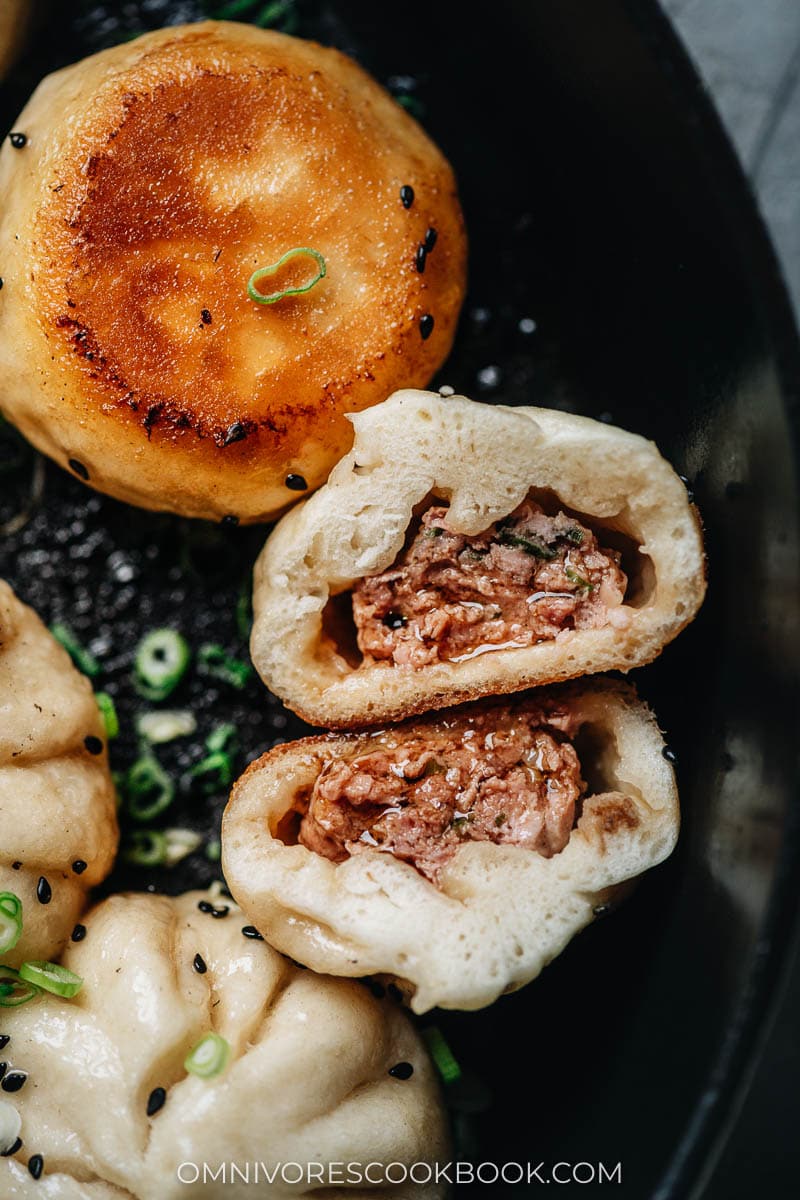
Also, you should know there are two ways to fry these sheng jian bao buns. The first method is to fry them pleat-side down. Or you can go with the flat-side down. I prefer using the latter method because it keeps the pleats pretty for a nice presentation and appearance.
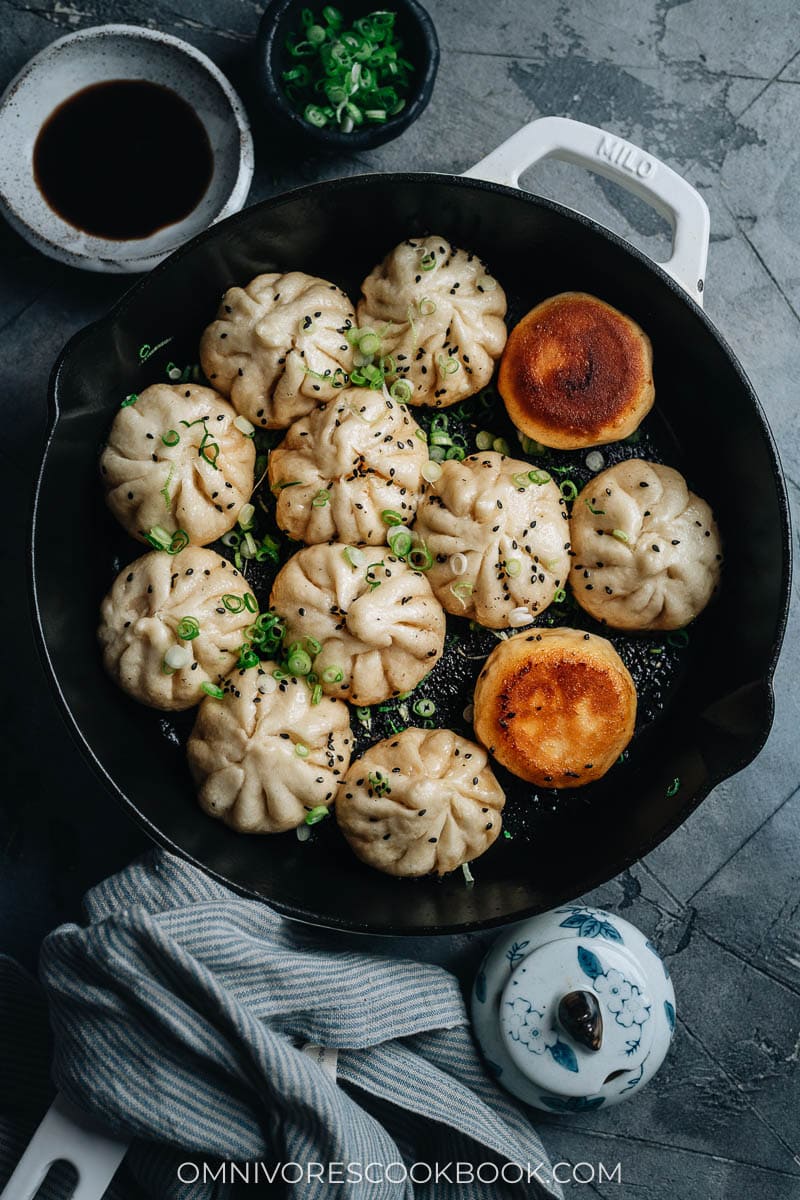
Ingredients
The best part of making Sheng Jian Bao at home is that it requires very basic ingredients you probably already have in your pantry.
NOTE: you will need to use instant yeast instead of dry active yeast. Because the yeast dough is a bit finicky when pan frying and steaming. Using instant yeast produces a more consistent result.
I listed the ingredients below just so you can see everything. When you make the dish, you don’t need to lay everything out in small plates.
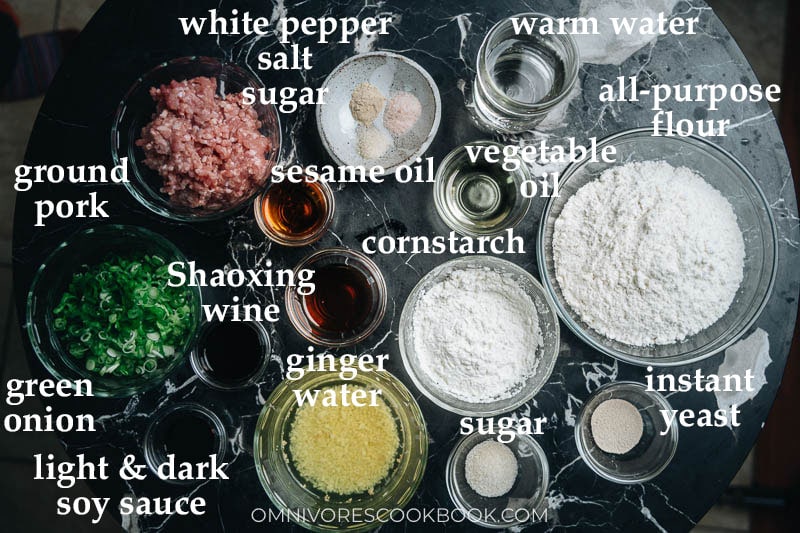
Cooking process
If you’ve made dumplings in the past, you’ll find the cooking process very straightforward. Even for a beginner, the dough is easy to put together. You don’t even need a stand mixer!
To prepare the dough and filling
- Combine all the dry ingredients
- Slowly add warm water and mix until the water is incorporated
- Knead by hand for 15 to 20 minutes
- Cover the dough with plastic wrap and let rest for 1 hour
- Mix the filling ingredients together and beat until sticky
- Add the green onion and sesame oil at the end, mix again. Cover and refrigerate until ready to use
- The dough is ready when the size doubles
- Gently knead for a minute to press out the air bubbles
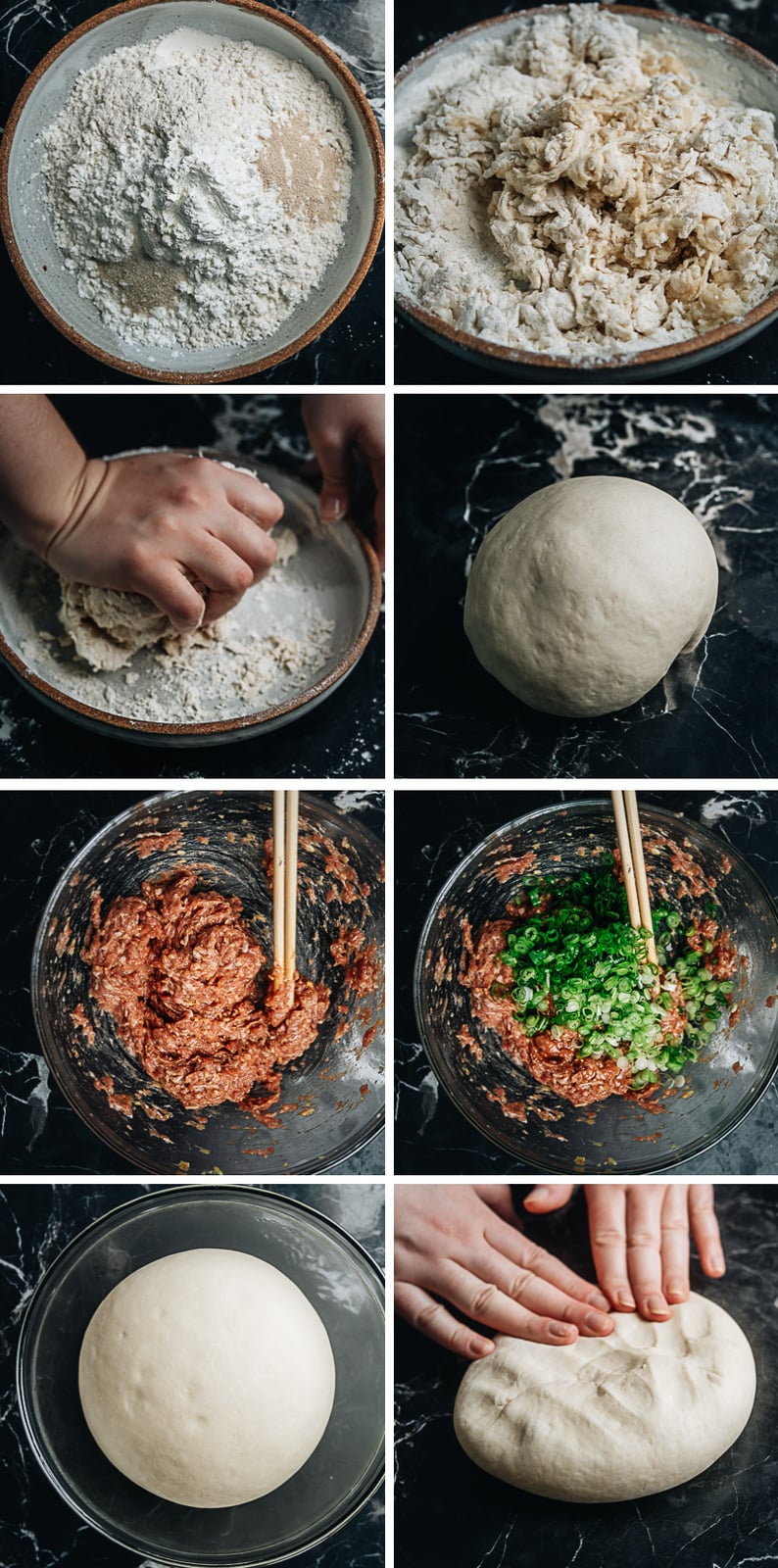
Assemble the buns
I highly recommend working on half a batch of buns at a time, so the dough won’t dry out and the filling won’t get soggy.
- Once you cut the dough in half and reserve the other half, make the half batch of dough into 12 pieces (see the video below for the detailed dough shaping method)
- Flatten the dough
- Roll it into a round disk
- Place 1 tablespoon of the filling onto the disk
- Start wrapping by folding the edges
- Keep folding until the bun is almost sealed
- Pinch together the top
- Slightly twist and seal
- Let the buns rest for 10 minutes before cooking
- Fry the buns to crisp up the bottom
- Add water and cover, to steam the buns
- Make sure you rest the buns once cooked, before you uncover and serve
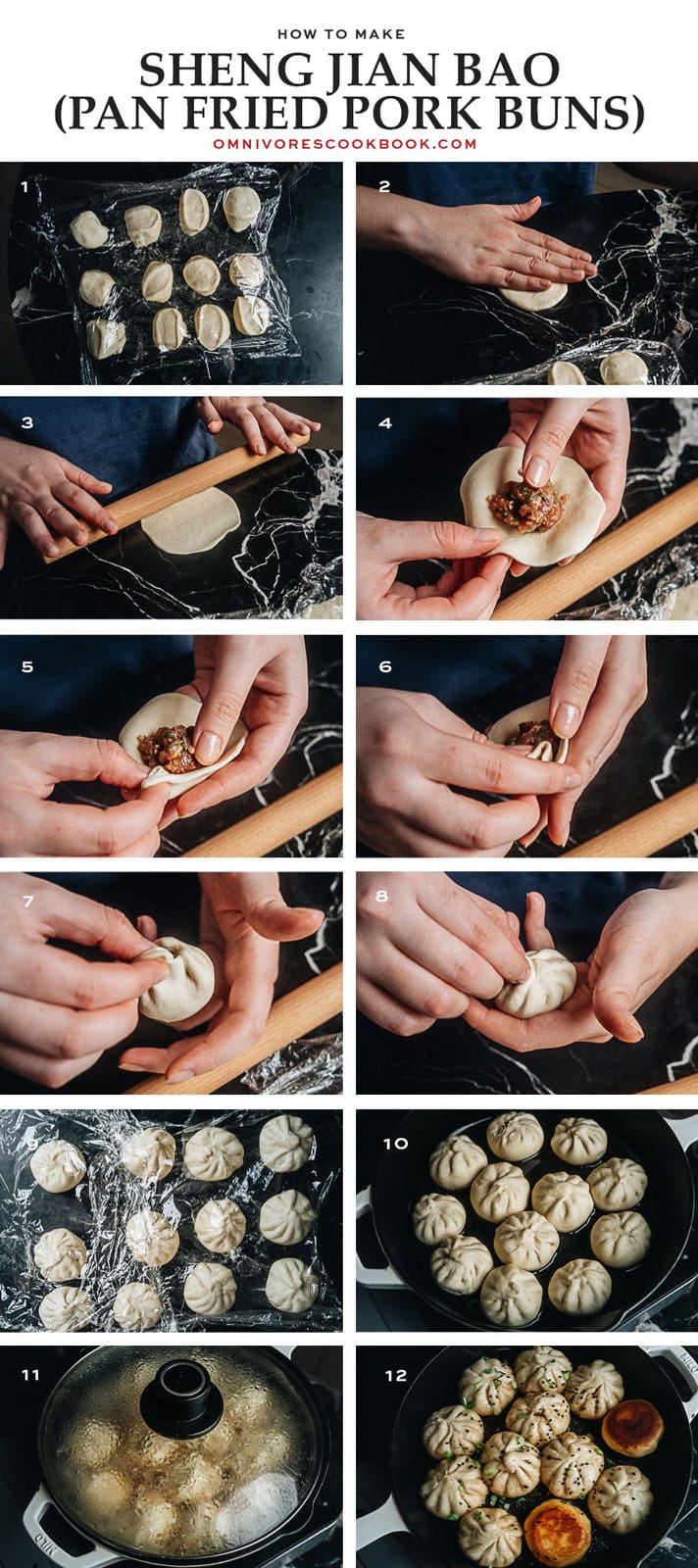
NOTE: I recommend serving the buns immediately after cooking, so the filling will be extra soupy. If you let the buns sit for a while, the juice will gradually be absorbed by the skin and lose its moisture. It will still taste delicious, but it won’t have the soup dumpling effect.
Afterthoughts
You can store your leftovers in the fridge or freezer. I like making a big batch and freezing them so my husband and I can enjoy them whenever the mood strikes!
As mentioned, in Shanghai, sheng jian bao is served for breakfast. I know the American palate is a bit different, though, so if you’re not keen on trying them for breakfast, make them as an appetizer or side dish for lunch or dinner. They’re so satisfying that you can even serve them as a main dish.
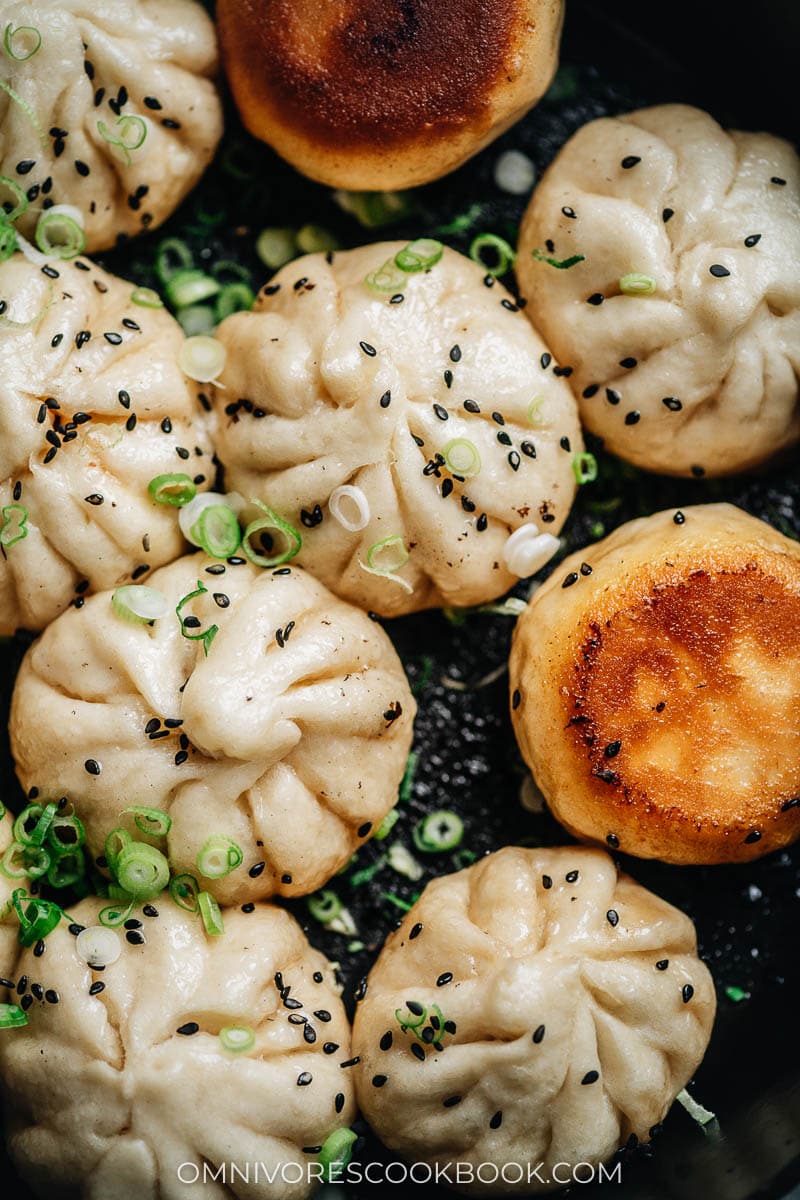
Want to learn more about Chinese Cooking? Sign up for my newsletter to receive the 5-Day Chinese Cooking Crash Course and recipe update!
Chinese Cooking Made Easy
Are you new to this website? This free email series is a great place to start. I’ll walk you through a few of my most popular recipes and show you how and why they work. You’ll quickly start to cook better Chinese food in your own kitchen.
Watch video
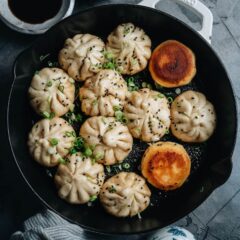
Sheng Jian Bao (生煎包, Shanghai Pan-Fried Pork Buns)
Ingredients
Ginger water
- 1 1/2 tablespoons ginger , minced
- 1/4 cup hot water
Dough
- 250 g (1 2/3 cup) all-purpose flour
- 50 g (1/3 cup + 1 tablespoon) cornstarch
- 4 g (3/4 teaspoon) instant yeast
- 5 g (1 teaspoon) sugar
- 150 g (2/3 cup) warm water (*Footnote 1)
- 15 g (1 tablespoon) vegetable oil
Filling
- 8 oz (227 g) ground pork (*Footnote 2)
- 1 1/2 teaspoons light soy sauce
- 1/2 teaspoon dark soy sauce (or soy sauce) (*Footnote 3)
- 2 teaspoons Shaoxing wine
- 1/2 teaspoon salt
- 1/4 teaspoon sugar
- 1/4 teaspoon ground white pepper
- 4 green onions , sliced
- 1 tablespoon toasted sesame oil
Cooking & Garnish
- 4 tablespoons vegetable oil
- 1/2 cup hot water , separated
- Chopped green onions , for garnish (Optional)
- Roasted sesame seeds , for garnish (Optional)
Instructions
Prepare ginger water
- Combine the minced ginger and hot water in a small bowl. Stir to mix well and set aside.
Prepare the dough
- In a large tall plate or a big bowl, combine the all-purpose flour, cornstarch, instant yeast and sugar. Stir to mix well.
- Slowly pour in the warm water, a few tablespoons at a time, and mix with a pair of chopsticks (or a fork). Once all the water has been added, keep mixing and scrape off the dry flour on the side of the bowl, until it forms many small dough flakes.
- Pour in the vegetable oil. Keep mixing with the chopsticks until the oil is absorbed.
- Start kneading by hand while further incorporating the dry flour, until there’s no dry flour left in the bowl.
- Transfer the dough onto a working surface. Knead for 15 to 20 minutes, until the dough is quite smooth and elastic and there’s no dry flour left in the bowl. It’s OK if there’s some unevenness in the dough, which will smooth out after resting. The dough should be quite tough and not sticky to the touch. Cover and seal the bowl with plastic wrap. Let rest until it doubles in size, 1 hour or so.
Prepare the filling
- Add the ginger water, light and dark soy sauce, Shaoxing wine, salt, sugar, and white pepper to the ground pork in a large bowl. Beat with a pair of chopsticks or a wooden spatula in a circular motion, until all the liquid is absorbed and the meat is sticky. This process might take a few minutes. (*Footnote 4)
- Add the green onions and sesame oil. Mix until they are incorporated. Cover the bowl with plastic wrap. Store in the fridge until ready to use.
Assemble the buns
- When the dough has rested, transfer to a work surface and punch it down. Knead for 1 minute to deflate the air out completely, then form it back into a ball.
- Cut the dough in half. Wrap half of the dough in plastic wrap and store in the fridge while working on the other half.
- Poke a hole in the center of the dough you’re working with. Stretch the dough into a large oval by running your fingers along the inside of the hole in a circular motion. Once the diameter of the dough is about 1” (2.5 cm), tear apart the ring so it creates a long, thin strip.
- Cut the dough strip into 12 even pieces by cutting it in half, then further cut each half into 6 pieces. Gently use a circular motion to round up each dough piece then flatten it with your palm. Cover them with plastic wrap to prevent drying out.
- Work on one piece of dough at a time – take one dough piece and place in front of you. Roll it with a rolling pin in one hand, using the other hand to rotate the dough while rolling, until the diameter reaches 5” (13 cm). You should keep the edges thinner than the center, so the wrapper of the bun will be even once you make the pleats.
- Place the rolled dough in your palm and add 1 tablespoon of filling in the center.
- Start wrapping the bun by folding and pinching the edge over itself, in one direction, until it is almost sealed. Then rotate and pinch the top of the pleats to fully seal the bun. (View my video for more details)
- Repeat with the remaining dough pieces to wrap all the buns. Keep the wrapped buns under a piece of plastic wrap to prevent drying out. Once done wrapping, let rest for 10 minutes. Once rested, you should cook the buns immediately. You can store the wrapped buns in a sealed container in the fridge for up to 1 hour before cooking.
- Repeat the wrapping steps to wrap the other half of the dough.
To cook the buns:
- Add 2 tablespoons of oil and carefully place 12 wrapped buns into a 9” or 10” skillet. Heat over medium-high heat until hot. Turn to medium heat. Cook, uncovered, for 3 minutes, until the bottoms are lightly browned.
- Pour about 1/4 cup hot water into the pan, just enough to cover the buns halfway up. Cover the pan and cook over medium heat for about 8 minutes, until the water is completely evaporated.
- Turn the heat to medium-low and cook for another 2 to 3 minutes. Turn the heat off and remove the pan from the stove. Let the buns rest with the lid on for an additional 2 minutes. Remove the lid and transfer to a plate. Repeat the steps to cook the rest of the buns.
- Serve hot immediately. (*Footnote 5) Or you can store the cooked buns in an airtight container in the fridge for up to 4 days or in the freezer for up to 3 months.
Notes
- The water should be slightly warmer than your body temperature.
- Although you can use any type of ground pork, a fattier one (e.g. 30% fat) will produce a juicier result.
- Dark soy sauce adds color to the filling, giving it the darker and more appetizing look once cooked. You can use soy sauce to replace dark soy sauce as well, but the color of the filling will come out lighter.
- It’s important to beat the filling really well, so the meat will absorb all the liquid and bind together. Once done, the meat will be easily formed into balls for the wrapping process. And once cooked, the liquid will release and create a juicy filling.
- The buns will be VERY juicy right after cooking. However, because the dough is very fluffy and it absorbs the juice fast, the buns will have less juice if you do not serve them immediately. The buns will still taste very delicious this way.
Nutrition

Did you make this recipe?
I’d love to hear how it turned out for you! Please take a moment to leave a 5-star rating ⭐️ and share your thoughts in the comments further down the page. It really helps others discover the recipe too.
If you give this recipe a try, let us know! Leave a comment, rate it (once you’ve tried it), and take a picture and tag it @omnivorescookbook on Instagram! I’d love to see what you come up with.
Other dumplings and buns recipes
- Gua Bao (Taiwanese Pork Belly Buns, 割包)
- Baked BBQ Pork Buns (Char Siu Bao)
- Chinese Steamed Custard Buns (nai wong bao, 奶黄包)
- Addictive Kimchi Pork Steamed Bun
- Chinese Pork Belly Bun (Rou Jia Mo, 肉夹馍)
Lilja Walter is a part of the Omnivore’s Cookbook team and worked closely with Maggie to develop and test this recipe.

Parsha
Is it ok to not use cornstartch because I dont have any.
Maggie Zhu
This recipe uses cornstarch to lower the gluten in the all-purpose flour for a better dough texture. I recommend using 290 g to 300 g cake flour to replace the all-purpose flour and cornstarch, if available.
If cake flour is not available, you can use all-purpose flour instead. But you will need to adjust the water quantity by feeling the dough.
Liz
I’m currently making these for the second time! I absolutely adore this recipe.
I was wondering, though, if you think it could work with measure for measure gluten free flour. I made the mistake of showing these to my celiac family members 😅
Thank you so much for sharing such an awesome recipe!
Pam
I have been eating this for a few days straight and suddenly thought that a char siu filling would go well with this. Would a char siu filling work for this recipe?
Maggie Zhu
You totally can! I have a char siu filling here: https://omnivorescookbook.com/baked-bbq-pork-buns/
Amy GH
I love this recipe! My teenagers beg for these buns. Thank you so much for sharing.
Maggie Zhu
So happy to hear you all like this one! Thanks for leaving a positive review 🙂
Amelia Correa
Third time I am making this recipe. Greetings from Mexico City. Love your work.
K. Frost
I made these, and they were a hit. Slightly too sweet for me but I did like them and so did the kids. Will make again. Thank you.
Teresa
Hi I love the recipe however I am getting conflicting views in relation to freezing the extras. Some say steam then freeze and others say to let’s it rise a little them freeze. Then cook from frozen. Can you please advise. I have tried frozen uncooked and it seems OK. Thank you
Maggie Zhu
I always prefer to freeze the cooked ones because I think the freezing and thawing process might affect the dough, and making them deflate during the cooking. That being said, I’m glad to hear you managed to freeze the uncooked buns without any issues. Do they turn out as good as the freshly steamed ones?